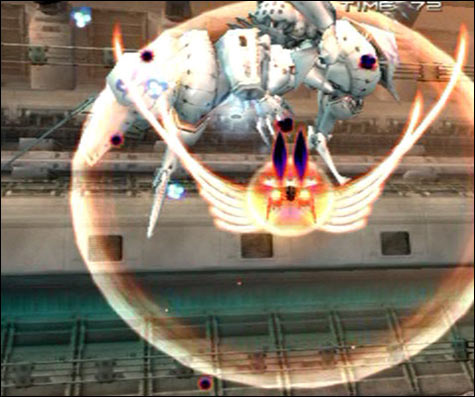
VISUAL POETRY: But achieving it is far from easy. |
Warning: if you’re the type to scream profanities and toss controllers when a game is too difficult, you’ll want to give Ikaruga a wide berth. Nominally a vertically scrolling shmup (the cool kids’ term for shoot-’em-up), it ends up feeling like some sadistic experiment to gauge your pain tolerance — just one electric shock after another as you keep reaching for that wedge of cheese. But the game is always fair, never cheap. And for a certain type of gamer, that pain might feel like pleasure.
In the years since its original release, the name Ikaruga has been spoken in hushed tones — and not just because nobody’s sure how to pronounce it. The game’s star-crossed development history seemed to doom it to cult status. Ikaruga was first an arcade game; then a minimal number of copies were released in Japan for Sega’s ill-fated Dreamcast. Finally Treasure managed to ship a GameCube version worldwide. Even so, the game has always been hard to come by, and both home editions still fetch high prices on eBay. Now, thanks to Microsoft’s Xbox Live Arcade service, a high-definition remake is available for download at a reasonable price. Those of us who missed it the first, second, and third times can discover what the fuss is about.

What distinguishes Ikaruga from most shmups is the gameplay. Rather than acquiring weapon and shield upgrades for your ship, you change its polarity on the fly, from white to black and then back again. Firing white lasers does double damage to black enemies, and vice versa. What’s more, your ship can absorb enemy fire if that fire matches your polarity, and if you absorb enough fire, you can release a torrent of devastating heat-seeking missiles. The field of play is continuously saturated with swarming foes and multi-colored enemy fire.
If you search for Ikaruga videos on YouTube and watch the experts play, you’ll see a kind of visual poetry that finds order in chaos. The player ship snakes through spiraling swaths of fire, anticipating each opponent’s movement. Rapid, timely shifts in polarity render the vessel invulnerable to the approaching fusillade, and its twin beams of energy pulverize enemy hulls. Through the maelstrom of combat, an elegant dance begins to show itself. Everything makes sense.
Then you fire up the game, ready for action, and you last all of 30 seconds before smashing into the game-over screen. Switching polarity isn’t as effortless as it appears, as there’s a slight but perceptible delay between the button press and the on-screen action. Reacting to what’s happening isn’t sufficient — you need to be predicting it. You realize that the guys who upload videos of themselves playing the game have memorized the exact location, trajectory, and polarity of thousands of enemies. Of course they make it look easy. They’re pros.
Success in Ikaruga demands a combination of innate talent and stubborn dedication to learning every detail of its brief but punishing levels. Lack either lightning-fast reflexes or the willingness to study and learn enemy attack patterns and you’ll find little to latch onto here. The reward for getting good at Ikaruga is being good at Ikaruga (and maybe uploading a YouTube video of your own). The craftsmanship — dare I say, the artistry — is apparent. But unless you’re an unapologetic perfectionist, this is a game that’s easy to admire and tough to enjoy.